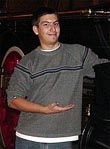|
|
 
|
|
Author
|
Topic: Adjusting Red Reader Without Test Film
|
Edward Jurich
Master Film Handler

Posts: 305
From: Las Vegas USA
Registered: Jul 2003
|
 posted 09-21-2004 09:12 AM
posted 09-21-2004 09:12 AM




This is possible if you need to install a red reader and don't have the test films. It will be set close enough to get by until it can be set with test tracks.
Once the red reader is installed and connected to the sound system. Use a couple of pieces of wire and jumper connect the left and right channels of the reader output, connect left - to right - and left + to right + . You have now a left + right, or mono, signal. Using a monitor in the booth that has a good high end frequency response, adjust the red reader while running stereo trailers or a feature until you hear the most highs or cleanest crisp sound. Lock the reader into position while listening, to make sure it stays in position. Now remove the jumper wires on the reader output. What's happening here is when connected mono, the stereo tracks are out of phase until the reader is set correctly. When out of phase, the high end will cancel and the sound will be muddy. When the reader is correctly set the high end will jump in as you are adjusting.
This is an old broadcast trick I used to set playback tape heads in a pinch.
Don't forget that when adjusting the reader, not only do you have to move the reader to and from the LED to focus, you also have to rotate the reader some. When you get close, small adjustments will make a big difference.
| IP: Logged
|
|
|
|
|
|
|
|
|
|
|
|
|
|
|
|
|
|
|
|
|
|
|
|
|
|
All times are Central (GMT -6:00)
|
|
Powered by Infopop Corporation
UBB.classicTM
6.3.1.2
The Film-Tech Forums are designed for various members related to the cinema industry to express their opinions, viewpoints and testimonials on various products, services and events based upon speculation, personal knowledge and factual information through use, therefore all views represented here allow no liability upon the publishers of this web site and the owners of said views assume no liability for any ill will resulting from these postings. The posts made here are for educational as well as entertainment purposes and as such anyone viewing this portion of the website must accept these views as statements of the author of that opinion
and agrees to release the authors from any and all liability.
|

 Home
Home
 Products
Products
 Store
Store
 Forum
Forum
 Warehouse
Warehouse
 Contact Us
Contact Us




 Printer-friendly view of this topic
Printer-friendly view of this topic
















